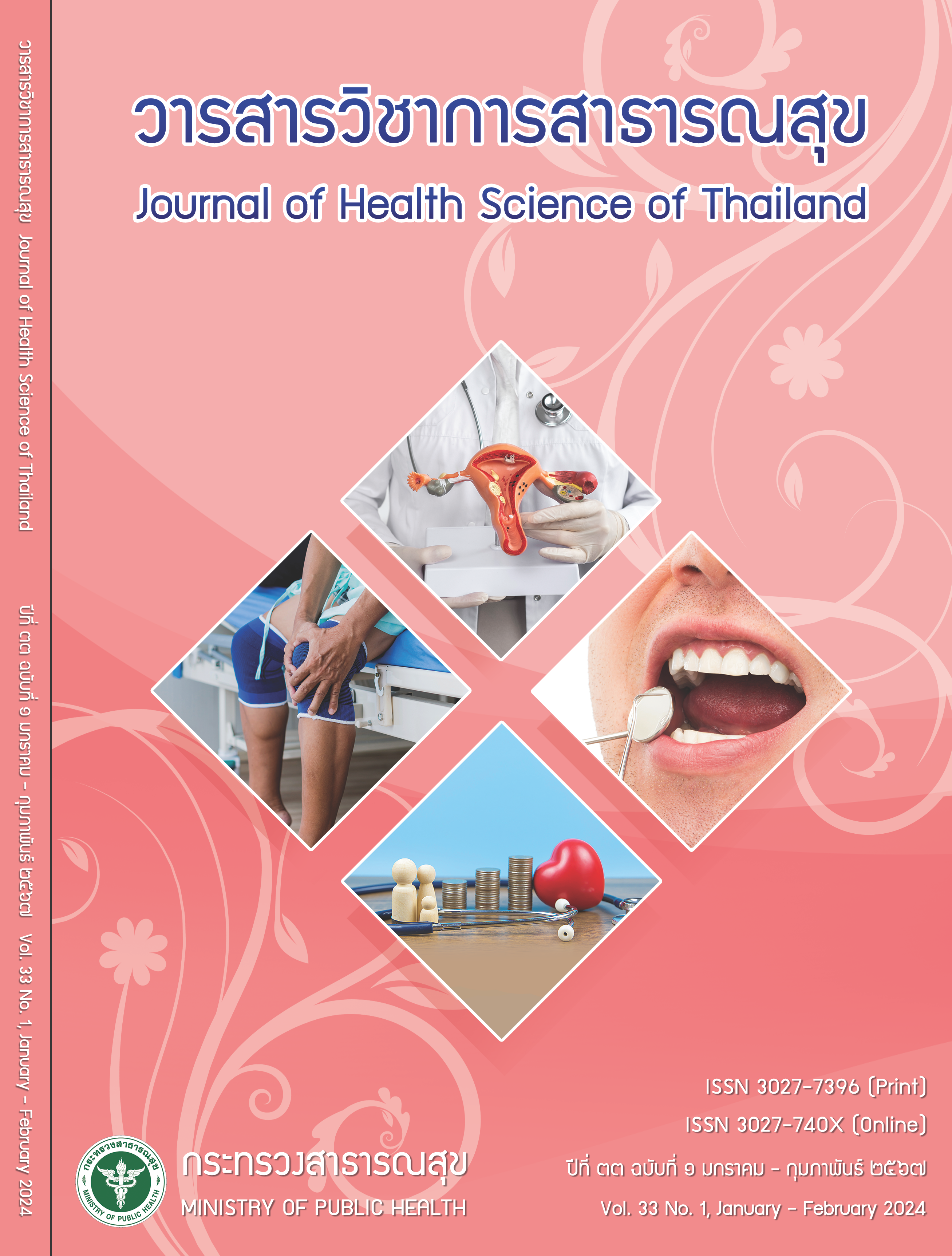Prevalence of HPV Strains Form Cervical Cancer Screening by HPV DNA Test of 14 High Risk Strains in Health Regional 3, Thailand
Keywords:
HPV, DNA test, cervical cancer, high-risk HPV strains, prevalence, Thai womenAbstract
Cervical cancer is a major public health problem that is mainly caused by infection with high-risk HPV strains. It can develop into cervical cancer. Therefore, this study aimed to determine the prevalence of HPV strains. From cervical cancer screening using HPV DNA 14, high-risk strains, in Thai women aged 30-60 years, a total of 28,870 people received cervical cancer screening services in 2021 at the Regional Medical Science 3, Nakhon Sawan Province. From the study, the prevalence of HPV infection was found to be 7.69%, with the prevalence of strains 16, 18 and high-risk strains other than strains 16/18 being 1.19%, 0.48, and 6.02%, respectively. The highest prevalences were strains 52, 16, 58 and 68 at 1.35%, 1.19%, 0.63% and 0.63%, respectively. When evaluating cytological abnormalities thin sheets of high-risk strains other than strains 16/18 the abnormalities were at 20.07 percent, of which the top 5 were strains 33, 52, 58, 31, and 56 at 28.57, 23.14, 23.08, 22.95, and 21.11 percent, respectively. In addition, the positive predictive value of the cervical biopsy results was found to be 56.35%, 51.78%, and 43.80 respectively. The results of the study can be used as information for selecting the HPV vaccine to be appropriate for the population in the area.
Downloads
References
Gargano J, Meites E, Watson M, Unger E, Markowitz L. Human papillomavirus (HPV). In: Roush SW, Baldy LM, Hall MAK, editors. Manual for the surveillance of vaccine-preventable diseases. Atlanta: Centers for Disease Control and Prevention; 2017. p. 5.1-7.
งานเวชระเบียนและฐานข้อมูลโรคมะเร็ง. ทะเบียนมะเร็ง ระดับโรงพยาบาล พ.ศ. 2563. กรุงเทพมหานคร: สถาบันมะเร็งแห่งชาติ; 2564.
Bansal A, Singh MP, Rai B. Human papillomavirus-associated cancers: a growing global problem. Ijabmr 2016;6(2):84-9.
Mayeaux EJ. Reducing the Economic Burden of HPV-Related Disease. J Am Osteopath Assoc 2008;108(2): S2-S7.
สุรพันธุ์ คุณอมรพงศ์, สุมาลี ศิริอังกุล. พยาธิวิทยาของปากมดลูก. เชียงใหม่ ภาควิชาพยาธิวิทยา คณะแพทยศาสตร์ มหาวิทยาลัยเชียงใหม่, 2561.
ศิริญญา เพชรพิชัย, ณัฐพร คล้ายคลึง, อมรรัตน์ โพธิ์ ตา, อนุกูล บุญคง, ปาริชาติ กัญญาบุญ. ความชุกของการติดเชื้อ Human papillomavirus สายพันธุ์ความเสี่ยงสูงของสตรีไทย ในพื้นที่ จังหวัดพิจิตร อุทัยธานี ชัยนาท และกำแพงเพชร. วารสารกรมวิทยาศาสตร์การแพทย์ 2564;63(4):766-81.
อรุณ จิรวัฒน์กุล, มาลินี เหล่าไพบูลย์, จิราพร เขียวอยู่, ยุพา ถาวรพิทักษ์, จารุวรรณ โชคคณาพิทักษ์, บัณฑิต ถิ่นคำระ, และคณะ. ชีวสถิติ. ขอนแก่น: คลังนานาวิทยา; 2551.
ปิยวัฒน์ เลาวหุตานนท์, อาคม ชัยวีระวัฒนะ, วีรวุฒิ อิ่มสำราญ. แนวทางการตรวจคัดกรอง วินิจฉัยและรักษาโรค มะเร็งปากมดลูก. กรุงเทพมหานคร: สถาบันมะเร็งแห่งชาติ; 2561.
อติพร อิงค์สาธิต. เอกสารประกอบการสอน เรื่อง หลักการ พิจารณางานวิจัยเกี่ยวกับการตรวจวินิจฉัยมาประยุกต์ใช้ใน เวชปฏิบัติ [อินเทอร์เน็ต]. มหาวิทยาลัยมหิดล. [สืบค้นเมื่อ 1 ก.พ. 2566]. แหล่งข้อมูล: https://www.rama.mahidol. ac.th/fammed/sites/default/files/public/pdf/EBM_Diagnostic_study.pdf
Sousa H, Tavares A, Campos C, Marinho-Dias J, Brito M, et al. High-Risk human papillomavirus genotype distribution in the Northern region of Portugal: Data from regional cervical cancer screening program. Papillomavirus Research 2019;100179:S1-S7.
ดุริยา ฟองมูล, มินตา นากอง, สมเกียรติ ลลิตวงศา, วรันกร เกยูรวงศ์. ความชุกและการกระจายตัวของการติดเชื้อไวรัสฮิวแมนแปปปิโลม่าชนิดความเสี่ยงสูงในโรงพยาบาลมะเร็ง ลำปาง. วารสารเทคนิคการแพทย์เชียงใหม่ 2558;48(3): 231-40.
Boonthum N, Suthutvoravut S. Prevalence, Types, and Associated Factors of HPV Infection Among Women With Abnormal Cervical Cytology Screening at Ramathibodi Hospital. Rama Med J 2021;44(3):12-9.
Rijkaart DC, Berkhof J, Kemenade FJ, Coupe VM.H,Hesselink AT, et al. Evaluation of 14 triage strategies for HPV DNA-positive women in population-based cervical screening. Int J Cancer 2011;130:602-10.
Kietpeerakool C, Kleebkaow P, Srisomboon J. Human papillomavirus genotype distribution among Thai woman with high-grade cervical intraepithelial lesion and invasive cervical: a literature review. Asian Pac J Cancer Prev 2015;16(13):5153-8.
Clarke MA, Risley C, Stewart MW, Geisinger KR, Hiser LM, et al. Age-specific prevalence of human papillomavirus and abnormal cytology at baseline in a diverse statewide prospective cohort of individuals undergoing cervical cancer screening in Mississippi. Cancer Medicine 2021;10:8641-50.
Downloads
Published
How to Cite
Issue
Section
License
Copyright (c) 2024 Ministry of Public Health

This work is licensed under a Creative Commons Attribution-NonCommercial-NoDerivatives 4.0 International License.







